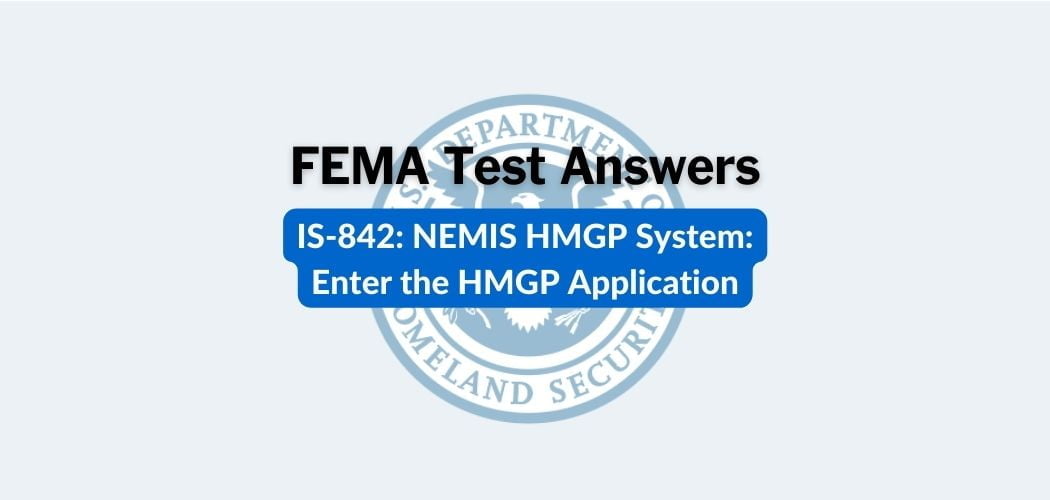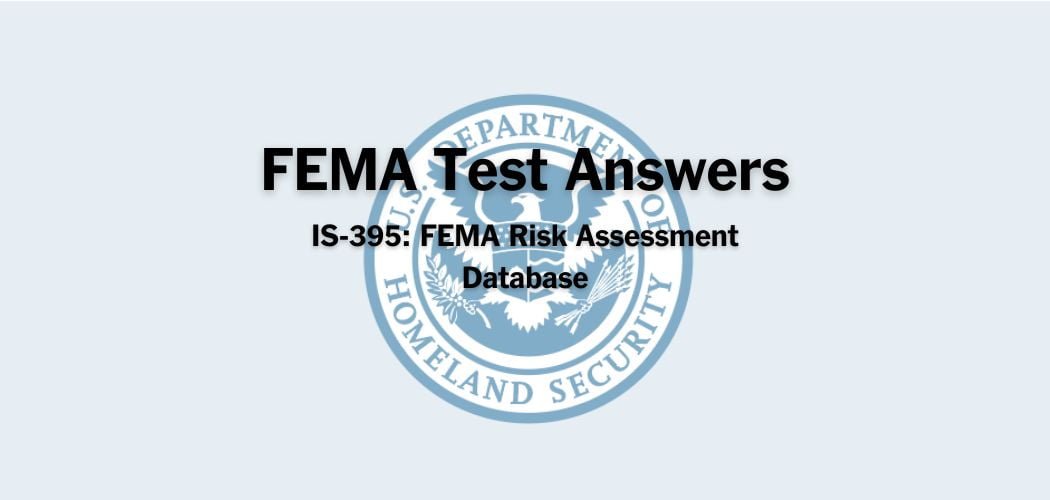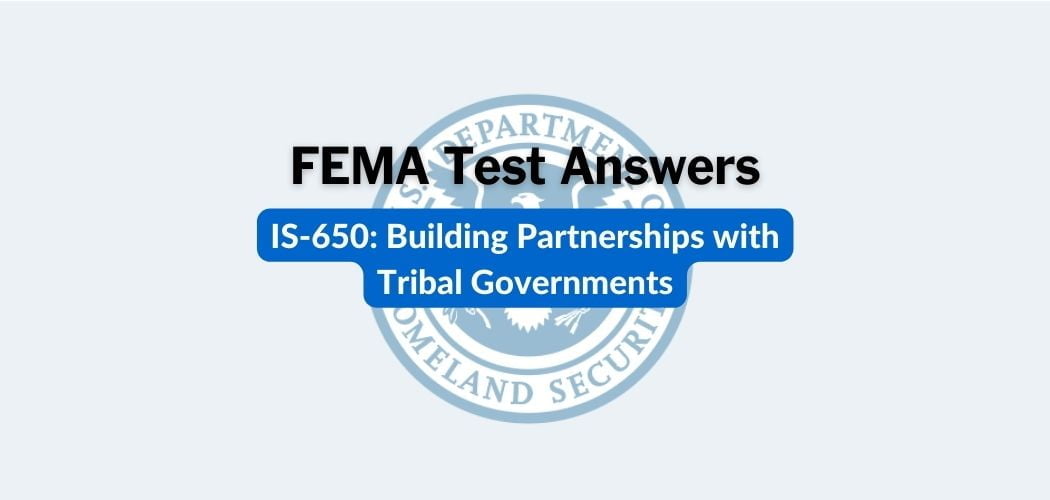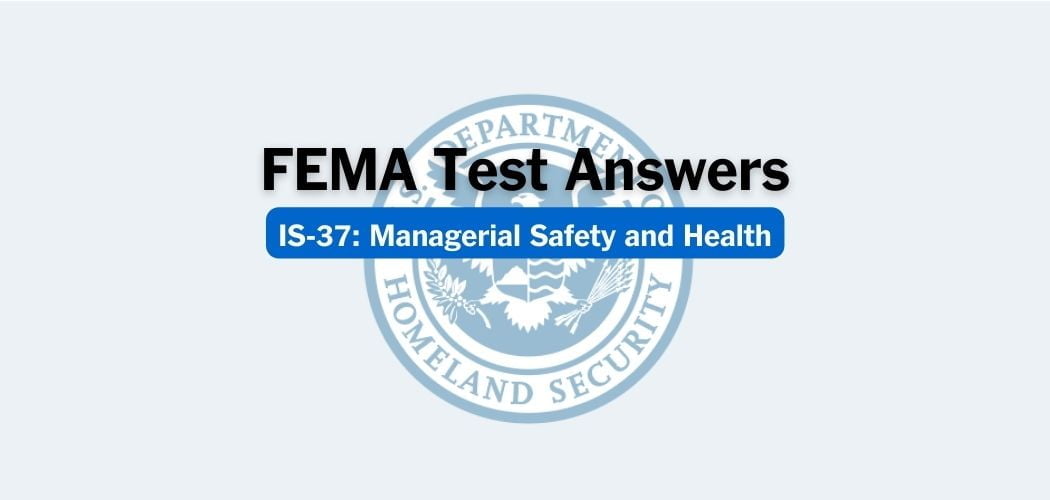Overview: The FEMA IS-2002 course was published on 6/8/2018 to maximize planning interoperability within FEMA and the national and regional interagency and to ensure proper coordination with the state, local, and tribal planners.
Primary audience: IS-2002 is for the below organizations throughout the U.S., with varying degrees of Internet access, systems, and knowledge.
FEMA IS-2002 test answers
Each time this test is loaded, you will receive a unique set of questions and answers. The test questions are scrambled to protect the integrity of the exam.
Question 1. The deliberate planning process begins when
A. When the planning notification is sent requesting personnel.
B. A supervisor gives the planning team leader an assignment.✅
C. The planning team leader develops the scope and the work plan.
D. An incident occurs.
Question 2. True or False: During Course of Action Comparison, the COAs are compared to each other.
A. TRUE
B. FALSE✅
Question 3. Regardless of how many annexes are included, the plan always concludes with the standard ______.
A. Annex X: Execution
B. Annex Z: Distribution
C. Both a and b✅
D. None of the above
Question 4. True or False: Response, Recovery, and Mitigation operational planning take place separately and in succession.
A. TRUE✅
B. FALSE
Question 5. What is the final step of the FEMA Operational Planning Process?
A. Plan Preparation, Review, and Approval
B. Plan Implementation and Maintenance✅
C. Plan Development
D. Understand the Situation
Question 6. Plans that do not fit into scheduled training may require _______ training
A. Refresher
B. Annual
C. Ad hoc✅
D. Online
Question 7. Approval of the Information Analysis Briefing (IAB) allows the planning team to proceed to
A. Determining goals and objectives
B. Course of Action (COA) development✅
C. Writing the plan
D. None of the above
Question 8. The base plan is made up of ______ paragraphs.
A. 3
B. 7
C. 5✅
D. 9
Question 9. There are seven standard annexes in the FEMA Deliberate Plan Outline. What is Annex A called?
A. Task Organization✅
B. Hazards
C. Charts
D. Execution
Question 10. The difference between Deliberate Plans and Crisis Action Plans is
A. Number of steps
B. Time constraint
C. Impact of incident✅
D. Planners involved
Question 11. Once the draft plan is written, who reviews it first?
A. The planning team leader
B. Partners and Stakeholders
C. The SLSC
D. The collaborative planning team✅
Question 12. Planning helps to identify
A. Operational gaps
B. Resource shortfalls
C. Risks that may adversely impact operations
D. All of the above.✅
Question 13. Each Course of Action description identifies
A. The logistics/support requirements.
B. The strategy to achieve the objective.
C. The required capabilities and resources.
D. All of the above.✅
Question 14. How are Stakeholders different from Partners?
A. Stakeholders provide resources; Partners do not.
B. Partners have responsibilities directly contributing to the plan’s completion; Stakeholders do not.✅
C. Stakeholders have responsibilities directly contributing to the plan’s completion; Partners do not.
D. They are the same.
Question 15. Objectives must be SMART. What does SMART stand for?
A. Specific, Meaningful, Attainable, Repeatable, and Time-oriented.
B. Specific, Measurable, Attainable, Relevant, and Time-oriented.✅
C. Safe, Measurable, Accurate, Repeatable, and Testable.
D. Safe, Meaningful, Accurate, Relevant, and Testable
Question 16. True or False: Revised plans should be checked to ensure they are still relevant and accurate. Substantive changes must be approved by senior leaders.
A. TRUE✅
B. FALSE
Question 17. Most information collected during the information analysis process can be grouped into what three categories of research?
A. Qualitative, quantitative, and mixed
B. Descriptive, operational capabilities, and risks and hazards.
C. Geographic factors, political considerations, and socioeconomic issues.
D. Operational environment, capabilities, and resource limitations and shortfalls.✅
Question 18. What does Operational Phase 2b indicate?
A. Activation, situational assessment, movement of resources, and life-saving and rescue operations.
B. Sustained response, including provision of accessible interim housing solutions, planning of immediate infrastructure repair and restoration, and supporting reestablishment of businesses.
C. Deployment of teams, providing for health and safety needs, sheltering, restoring critical systems, and establishing structures for long-term recovery.✅
D. Long-term, sustained recovery operations, including permanent housing solutions, mitigation strategies, and economic revitalization.
Question 19. What is the purpose of exercising plans?
A. To educate participants
B. To evaluate the plan.
C. To maintain the plan
D. All of the above.✅
Question 20. True or False: The standard format of the FEMA operational plan is designed to allow planners to transition planning materials into the written plan.
A. TRUE✅
B. FALSE
Question 21. True or False: Crisis action planning follows the same 6 steps as deliberate planning.
A. TRUE✅
B. FALSE
Question 22. What does Operational Phase 1c indicate?
A. Near certainty or credible threat✅
B. Increased likelihood or elevated threat
C. Normal operations
D. Activation and situational assessment
Question 23. What is not included in the senior leader’s intent?
A. Purpose of the plan
B. Desired end state
C. Courses of action✅
D. Specific tasks
Question 24. What does the Incident Strategic Plan (ISP) do?
A. Directs incident management and defines specific milestones that must be accomplished to achieve the desired end state.✅
B. Details the strategy the Federal Disaster Recovery Coordinator and Recovery Support Function agencies will take to support the SLTT.
C. Focuses on one particular function or programmatic issue.
D. Estimates short-term resource requirements and anticipates activities three to seven days beyond the current operational period.
Question 25. True or False: Information analysis involves all planning team members, partners, and stakeholders.
A. TRUE✅
B. FALSE
Question 26. Which is not a core capability?
A. Prevention✅
B. Response
C. Mitigation
D. Recovery
Question 27. The statement expressing what will be accomplished and how it will be done is called.
A. Concept of operations✅
B. Concept of support
C. Concept of actions
D. Concept of situation
Question 28. The Information Analysis Briefing (IAB) generally includes
A. Mission Statement
B. List of objectives
C. Detailed information reflecting the research/analysis
D. All of the above.✅
Question 29. Which step of the FEMA Operational Planning Process is “Plan Development?”
A. Fifth
B. Second
C. Fourth✅
D. Sixth
Question 30. Which is not something that information analysis allows planners to do?
A. Bypass course of action analysis.
B. Determine physical effects and operational impacts✅
C. Identify threats and hazards and develop planning scenarios
D. Identify critical facts and assumptions
Question 31. Which of the following is not one of the 5 minimum characteristics of viable Courses of Action?
A. Completeness.
B. Feasibility.
C. Distinguishability.
D. Thoroughness✅
Question 32. A definition of “planning factors” could include?
A. Quantitative descriptions of problems✅
B. Qualitative descriptions of problems.
C. The basis planners use to develop objectives and courses of action
D. All of the above.
Question 33. What is the third step of the FEMA Operational Planning Process?
A. Determine Goals and Objectives✅
B. Plan Implementation and Maintenance.
C. Plan Preparation, Review, and Approval.
D. Understand the Situation



